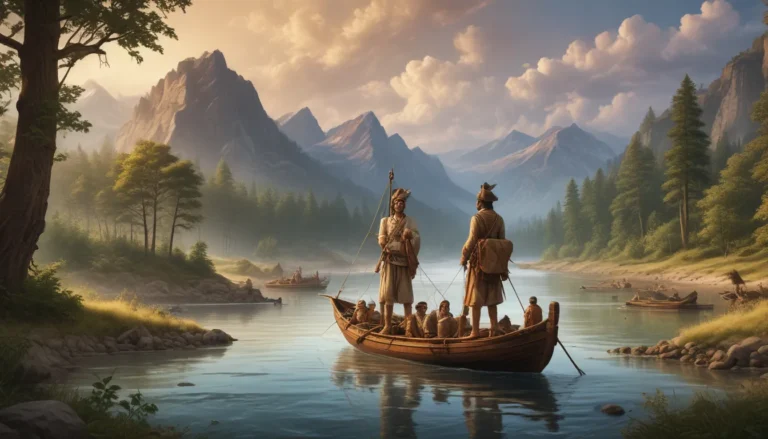The images in our articles may not match the content exactly. They are used to grab your attention, not to show the exact details in the text. The images complement the text but do not replace it.
Welcome to the enchanting world of the Inca Trail, a legendary trek that winds its way through the majestic Andes Mountains, leading intrepid hikers to the awe-inspiring ancient city of Machu Picchu. This iconic route offers a glimpse into the rich history and captivating natural beauty of Peru, making it a bucket-list adventure for countless travelers. Join us as we embark on a virtual journey through time and terrain, uncovering the secrets and wonders that have captivated explorers for centuries. From the trail’s historical significance to its ecological diversity, each fact unveils a new layer of intrigue, shedding light on the allure of this legendary pathway. So, lace up your virtual hiking boots and get ready to explore the mystique and marvels of the Inca Trail.
Delving into the Inca Trail Experience
The Inca Trail is a renowned hiking route that winds its way through the Andes Mountains, covering roughly 26 miles of breathtaking terrain. This ancient trail offers hikers an immersive experience, allowing them to traverse diverse landscapes, including cloud forests, mountain passes, and captivating Incan ruins. At the end of the arduous trek, hikers are rewarded with a spectacular and awe-inspiring sight: the magnificent Machu Picchu. This iconic Incan citadel, nestled high in the Andes, serves as the ultimate destination for those who conquer the challenging Inca Trail.
Unveiling the Trail’s Rich History
Centuries ago, the Inca civilization meticulously crafted this trail, utilizing intricate stone masonry to pave the way for their messengers and pilgrims. The trail’s construction represents a remarkable feat of engineering and stands as a testament to the ingenuity of the Incan people. As hikers traverse the path, they encounter a series of captivating Incan archaeological sites, each shrouded in history and mystery. These remnants of an ancient civilization add an enchanting allure to the journey, offering a unique glimpse into the past.
Exploring the Diverse Ecosystems
Throughout the journey, hikers encounter a rich tapestry of ecosystems, ranging from lush cloud forests teeming with diverse flora and fauna to high-altitude alpine tundra. The ever-changing surroundings add depth and wonder to the hiking experience, providing a true immersion in nature’s beauty. The highest point along the trail is the infamous Dead Woman’s Pass, standing at an elevation of approximately 13,800 feet, presenting a formidable challenge for hikers and testing their endurance and determination.
Planning and Preparation for the Trek
Hiking the Inca Trail requires physical preparation and a permit. In order to preserve the trail and limit environmental impact, the Peruvian government mandates that hikers obtain a permit to embark on the Inca Trail. This measure helps regulate foot traffic and ensures the trail’s sustainability for future generations. Given the trail’s demanding terrain and high altitude, hikers are advised to undergo physical training and acclimatization to ensure they are adequately prepared for the arduous journey ahead. Optimal hiking conditions are typically found during the dry season, spanning from May to September, offering hikers favorable weather and clearer views.
Immersing in the Culture and Heritage
Beyond its natural splendor, the Inca Trail provides hikers with a profound cultural immersion, allowing them to connect with the rich heritage and traditions of the Andean people and the ancient Incas. Recognized for its cultural and natural significance, the Inca Trail holds the prestigious designation of being a UNESCO World Heritage Site, underscoring its importance as a historical and environmental treasure. Most hikers embark on a four-day trek along the Inca Trail, which allows for a well-paced and immersive journey through the varied landscapes and historical sites that define this iconic route.
Appreciating the Rewards of the Journey
Throughout the expedition, hikers are treated to sweeping vistas of the Andes Mountains, verdant valleys, and the winding Urubamba River. These awe-inspiring panoramas provide moments of tranquility and inspiration along the challenging trail. As hikers venture through the trail’s diverse ecosystems, they may encounter a myriad of wildlife, including Andean spectacled bears, vibrant bird species, and unique flora that thrive in the trail’s distinct microclimates. During clear nights along the trail, hikers are treated to breathtaking celestial displays, as the remote locations and high altitudes provide ideal conditions for stargazing and connecting with the awe-inspiring night sky.
Embracing Challenges and Rewards
Embarking on the Inca Trail is a journey marked by both physical exertion and moments of profound beauty, offering a balanced blend of challenges and rewards that culminate in a deeply enriching experience for those who undertake the trek. To maintain the trail’s sustainability and protect its natural and cultural integrity, the Peruvian government restricts the number of daily permits issued for hiking the Inca Trail, underscoring the importance of planning and securing reservations in advance. For many hikers, the Inca Trail represents more than a physical adventure—it serves as a spiritual odyssey, allowing individuals to connect with the ancient energies and sacred sites that permeate the trail, fostering a profound sense of introspection and reverence.
Conclusion
In conclusion, the Inca Trail is not just a hiking route; it’s a journey through history and nature. Its ancient pathways, breathtaking scenery, and archaeological wonders offer a unique experience for adventurers and history enthusiasts alike. The trail’s significance as a part of the Incan road system and its leading role in the exploration of Machu Picchu make it an iconic destination. As visitors trek through the Andean landscape, they not only witness the beauty of Peru but also connect with the legacy of the Inca civilization. The Inca Trail stands as a testament to human ingenuity and endurance, inviting modern-day explorers to follow in the footsteps of the ancient Incas and discover the wonders they left behind.
FAQs
What is the significance of the Inca Trail?
The Inca Trail holds immense historical and cultural significance as it served as a vital part of the extensive Incan road system. It was a route of great importance for the Incas, connecting various regions of their vast empire and leading to the renowned citadel of Machu Picchu.
How difficult is the Inca Trail hike?
The Inca Trail hike is considered moderately challenging, featuring steep ascents, high altitudes, and varied terrain. While it demands physical fitness and acclimatization to the altitude, it rewards hikers with stunning views and an unforgettable journey through ancient history and natural beauty.
Are you inspired by the wonders of the Inca Trail? Dive deeper into the adventure with our article on the grueling Inca Trail Marathon, where runners push their limits amidst ancient ruins and stunning vistas. From training tips to race-day strategies, we’ve got you covered for this ultimate test of endurance.
Was this page helpful?
Our commitment to delivering trustworthy and engaging content is at the heart of what we do. Each fact on our site is contributed by real users like you, bringing a wealth of diverse insights and information. To ensure the highest standards of accuracy and reliability, our dedicated editors meticulously review each submission. This process guarantees that the facts we share are not only fascinating but also credible. Trust in our commitment to quality and authenticity as you explore and learn with us.






